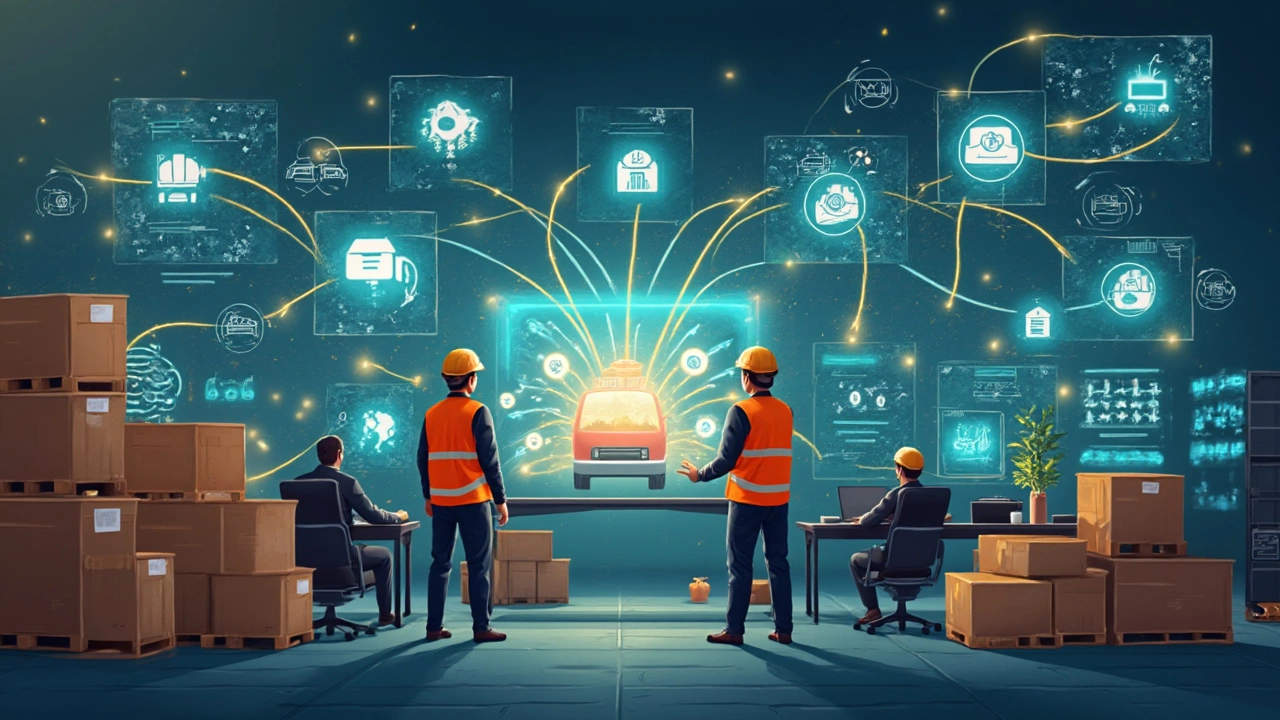Supply chain runs on software now—there’s no way around it. If you’re still using spreadsheets or old-school emails to track shipments, you’re basically driving with the handbrake on. Mistakes add up fast: missed delivery windows, piles of lost inventory, and customers who don’t come back. That’s why understanding which software actually powers the supply chain is such a game changer.
Here’s the secret a lot of tech vendors won’t tell you: not every business needs the flashiest system. What matters is picking software that solves your real, everyday headaches. Sure, you’ll see fancy names like WMS (Warehouse Management System), TMS (Transportation Management System), and ERP (Enterprise Resource Planning) tossed around. But each one has its own strengths, and the best choice depends on where you feel the most pain—be it tracking stock, keeping trucks full, or just getting everyone in the loop quickly.
We'll pull apart the main types, look at real examples, and call out some unexpected essentials you might overlook. Plus, there are some clever ways pros save time (and money) by making these systems talk to each other, cutting manual work and lowering errors. Stick around and you’ll finish with a clearer picture of what’s really worth your budget—and what’s just hype.
- Why Logistics Needs Specialized Software
- The ‘Big Three’: ERP, WMS, TMS Explained
- Other Essential Supply Chain Tools
- Choosing the Right Software for Your Needs
- Smart Integration: How Systems Work Together
- Trends Shaping Supply Chain Software in 2025
Why Logistics Needs Specialized Software
If you’ve ever tried managing shipments, inventory, or customer orders by hand, you know what a mess it can turn into. Even a small error—like mixing up two pallets or sending a package to the wrong place—can cost real money. That’s why supply chain businesses use supply chain software designed just for logistics. It’s not about adding bells and whistles. It’s about cutting down on mistakes and working faster.
The numbers speak for themselves. According to a 2024 report from Gartner, companies with dedicated logistics software reduced operational costs by up to 20% compared to those using manual methods. That’s massive, especially with tight margins. Plus, software helps teams respond to surprises, like a truck breakdown or a sudden spike in demand, way faster than phone calls and paperwork ever could.
Let’s break down why specialized software is now basically required in logistics:
- It tracks everything in real time—so you know what you have, where it is, and where it’s going.
- It connects everyone on your team, from drivers to warehouse staff, so there are fewer mix-ups.
- It automates boring, error-prone tasks like labeling, invoicing, and scheduling shipments.
- It stores data, so you actually learn from past mistakes and spot patterns you’d never catch by hand.
Here’s a snapshot of how using specialized software helps companies:
| Task | Manual Process | With Logistics Software |
|---|---|---|
| Order Tracking | Phone calls/emails to check orders | Instant online dashboard updates |
| Inventory Management | Handwritten logs/spreadsheets | Automatic real-time updates |
| Invoice Creation | Manual entry per order | Automatic invoice generation |
| Error Rate | High, especially as order volume grows | Much lower, scales easily |
Think about this: Amazon isn’t king of logistics because its workers are superhuman. It’s their software that does the heavy lifting—tracking millions of items, routing trucks, and flagging delays before they turn into customer complaints. That’s what even smaller businesses can tap into now, thanks to all these specialized tools.
The ‘Big Three’: ERP, WMS, TMS Explained
When it comes to running a supply chain, most of the serious work happens inside three types of software: ERP, WMS, and TMS. These aren't just more acronyms—they’re what actually keep goods moving and costs under control in modern logistics.
First up, ERP (Enterprise Resource Planning) is the big boss of business software. Think of it like the brain: it keeps your numbers, orders, payments, and even HR in one place. Big names here include SAP, Oracle, and Microsoft Dynamics. ERPs tie everything together, but they can be clunky if you only want to track inventory or book a truck. The great thing is, if you’re growing fast, an ERP can scale right up with you. Still, these systems are often expensive—big players spend millions on implementation, though smaller, cloud-based options have made ERPs more accessible in the last couple years.
Next is WMS (Warehouse Management System). This one is all about tracking what’s coming in, what’s going out, and where things are inside the warehouse. It powers things like barcode scanning, picking lists, and even slotting items for faster delivery. Some top WMS choices are Manhattan Associates, Blue Yonder, and Oracle WMS. Here’s a cool fact from a recent 2024 survey: warehouses using WMS see up to 30% faster order picking and can cut errors by 70%. That’s real money saved—they keep customers happier too.
Then you’ve got TMS (Transportation Management System). This one’s for everything that moves your products outside the warehouse: booking trucking lanes, finding the cheapest rates, handling routing, and tracking shipments. Top brands? Look for Oracle TMS, SAP TM, MercuryGate, and Transporeon. A TMS makes a difference when you start shipping serious volume—say, dozens or hundreds of shipments a day. It helps businesses cut freight costs, optimize delivery times, and—crucially—gives you real-time tracking when your customers start asking, "Where’s my order?"
Check out how these three stack up in use cases and key benefits:
| Software | Main Focus | Who Uses It? | Top Vendors | Key Stat |
|---|---|---|---|---|
| ERP | Business-wide planning (accounting, procurement, HR, inventory) | Large and mid-size companies, multi-department teams | SAP, Oracle, Microsoft Dynamics | Boosts supply chain visibility up to 95% |
| WMS | Warehouse inventory, inbound/outbound logistics, picking accuracy | Warehouses, 3PLs, retail distributors | Manhattan Associates, Blue Yonder, Oracle WMS | Cuts picking errors up to 70% |
| TMS | Transportation, carrier management, route optimization | Shippers, manufacturers, logistics teams | Oracle TMS, SAP TM, MercuryGate | Reduces freight costs by 6–12% |
Most companies end up using more than one piece of supply chain software as they grow, blending these systems to tackle their unique mix of warehouse chaos, shipping headaches, and business paperwork. The real trick is matching the software to your pain points and size, so you get results without drowning in features you’ll never use.
Other Essential Supply Chain Tools
Think the basics end with ERP, WMS, and TMS? Not even close. There’s a stack of other tools out there making modern supply chains tick. Some of these will save your sanity on a daily basis, especially if you’re wrangling lots of moving parts or tight deadlines.
First up: Inventory Management Systems (IMS). While some WMS tools cover inventory, IMS software is all about tracking how much you’ve got, where it is, and what needs ordering. Good ones—like Netstock or Zoho Inventory—alert you before you run out, which beats finding empty shelves when your customer calls. If your business sells both offline and online, an IMS can link your e-commerce platforms and brick-and-mortar stores so stock levels are always in sync.
Procurement software deserves a callout. Tools like Coupa, Jaggaer, or SAP Ariba take the pain out of buying supplies. They automate purchase orders, match them to invoices, and help you compare vendors without endless emails or spreadsheets. Less paperwork, fewer surprises.
Supplier Relationship Management (SRM) tools help keep your partners close. These systems go beyond tracking contacts—they monitor supplier performance, organize scorecards, and flag issues before they blow up. One example is Ivalua, trusted by some huge brands to build a steady and reliable supply base.
Don’t forget Demand Planning software. Getting forecasts right is half the battle. Tools like Kinaxis or Blue Yonder crunch past sales data, factor in seasonality, and spit out predictions so you don’t wildly overstock—or run dry when demand pops. Even better, they update forecasts as new data rolls in.
Finally, there’s a rise in supply chain visibility platforms. These show, in real time, where shipments are, if they’re delayed, or if a shipment’s temperature is creeping out of range (think pharma or food). FourKites and Project44 are two leaders, making it easier to spot problems before they snowball. Getting everyone on the same page here means less finger-pointing and fewer status update calls.
Want smoother order fulfillment, lower costs, and fewer supply chain surprises? Mixing the right combo of these tools with your supply chain software setup is a big step in the right direction.

Choosing the Right Software for Your Needs
Let’s be honest—choosing the right supply chain software is overwhelming. You’re hit with options from big players like SAP and Oracle, all the way to focused tools like NetSuite or Manhattan Associates. The trick? Don’t let brands blind you. Focus on what gaps you actually have, and fix those first.
The smartest way is to list out your current headaches. Are orders getting lost? Does your warehouse inventory not match reality? Are drivers wasting time with paperwork? Your answers point toward the type of solution you need, like a WMS for stock messes or a TMS if deliveries are your pain point.
- Small businesses often start with something basic—Fishbowl or Zoho Inventory, which are easy to learn and cheap to run. It keeps costs predictable.
- Mid-size operations might jump right to NetSuite or Microsoft Dynamics. Both handle inventory, accounting, sales, and can connect with shipping software like ShipStation.
- Enterprises often need all-in-one ERP beasts—think SAP S/4HANA or Oracle SCM Cloud—which handle everything from purchase orders to predictive analytics, but demand a serious budget and experienced staff.
It’s tempting to look for “best all-around” software, but there’s no such thing. Each industry, and even each business, needs something a bit different. Food producers care about tracing every ingredient batch, while e-commerce shops are obsessed with lightning-fast order picking and shipping.
Here’s a quick look at what real users value most when picking supply chain tech:
| Feature | Why It Matters | Popular With |
|---|---|---|
| Real-time inventory tracking | Keeps your stock numbers accurate to the minute | Retailers, warehouses |
| Easy integration | Makes new software play nice with old systems | Everyone, but especially growing firms |
| Cloud access | Log in anywhere—no more being tied to your desk | Field teams, remote managers |
| Automated alerts | Cuts out phone calls and emails—problems get flagged automatically | Operations managers |
| Customizable dashboards | See exactly the info you need, nothing else | Executives, team leads |
If you’re serious about avoiding buyer’s remorse, try this:
- Sketch out your current processes, bottlenecks, and key people involved.
- Make a short list of “must have” and “nice to have” features before talking to any vendors.
- See if your shortlist connects well with software you’ve already got—avoiding double data entry is huge.
- Test drive demos with your actual data, and let your real users give feedback—not just managers.
- Check reviews that point out customer support; even the best software turns bad without decent help.
And a final pro tip: software that’s great today needs to keep up tomorrow. So as your business grows, make sure the system can add users, handle more orders, or connect upgrades without a meltdown. Scalability isn’t a luxury, it’s a must-have.
Smart Integration: How Systems Work Together
Here’s the deal—supply chain software shines brightest when it’s all connected. Imagine trying to run a warehouse on one system, shipping on another, and your finances on something else, all without them talking to each other. That’s a recipe for delays, bad data, and headaches nobody wants.
The big players—ERP, TMS, WMS—work best when they’re sharing info in real time. For example, when your supply chain software automatically updates inventory as soon as a shipment leaves the dock, you’re not just cutting paperwork: you’re making sure sales, accounting, and delivery all see the same story. No double-checking, less “Where did it go?” finger pointing.
- APIs (Application Programming Interfaces) are the real MVPs behind all this. They let different software systems swap data instantly—think your ERP talking directly to your TMS, so tracking shipments and billing customers happens without manual entry.
- Cloud-based platforms have made integration way easier and cheaper than a decade ago. Instead of hiring a small IT army, many businesses now connect systems via drag-and-drop tools like Zapier, Celigo, or native integrations built right into modern logistics platforms.
- Even older systems can usually be upgraded or linked with add-ons that sync important info. Some companies run a “middleware” layer in between to patch things together, no need to ditch everything and start over.
Gartner summed it up:
"End-to-end integration across supply chain functions is no longer a luxury—it's table stakes for competitiveness in 2025."
Want a tip? Before you buy anything new, make a list of what your team always types in twice (or more). That’s where integration will save you the most time right off the bat. Also, check if your current software can handle open APIs—if not, it’s a red flag you’ll run into trouble syncing stuff later.
With all these tools speaking the same language, you’ll spot problems way sooner. No nasty surprises, no scrambling to fix issues after the fact. That’s how smart businesses are making supply chain tech really work for them.
Trends Shaping Supply Chain Software in 2025
If you haven’t checked out the new trends in supply chain software this year, you’re already falling behind. In 2025, the game is moving fast, and what worked even a couple of years ago could turn into a headache now. Instead of vague predictions, here’s what’s actually happening on the ground.
1. AI and Machine Learning Are Everywhere
No, it’s not just a buzzword. In 2025, AI-driven demand forecasting and smart route planning are standard in most logistics platforms. Big names like Oracle and SAP now bundle smart forecasting tools that help cut inventory costs and head off shortages. According to Gartner, 73% of large supply chain companies are using at least some AI for planning or risk management.
2. Cloud-Based Systems Win Over Old-School Software
If you’re still running your logistics suite on a local server, you’re missing out. Cloud-based tools let teams work from anywhere and scale up or down instantly. A 2025 survey from Statista shows 81% of companies with over $50M revenue have moved their main supply chain system to the cloud.
3. Real-Time Data (No More Blind Spots)
Modern platforms share live feeds from IoT gadgets—think GPS trackers in trucks and sensors in warehouses. No more waiting for end-of-day updates. You know what’s in your inventory and when it’ll arrive, almost down to the minute.
4. Sustainability Tools Are Built-In
With all the new eco rules and consumer pressure, software now helps track your carbon footprint right inside the dashboard. Some platforms suggest greener shipping routes and find vendors with better eco scores.
5. Easy Integrations
Nobody wants a setup that takes six months and an army of consultants just to connect ERP and TMS systems. Now, new platforms come with plug-and-play integrations—APIs that let you instantly connect with your e-commerce site, CRM, and even third-party apps like ShipStation or Shopify.
| Trend | 2023 Usage Rate | 2025 Usage Rate |
|---|---|---|
| Cloud-Based Systems | 62% | 81% |
| AI-Driven Forecasting | 39% | 73% |
| Real-Time IoT Tracking | 44% | 68% |
| Integrated Sustainability Features | 23% | 50% |
Bottom line: the new wave of supply chain software is all about working smarter—less time wasted, faster reactions, and fewer surprises. If you’re making decisions about logistics tools this year, don’t just look at basic features. Make sure your system has these new essentials, or you’ll risk being left behind.





